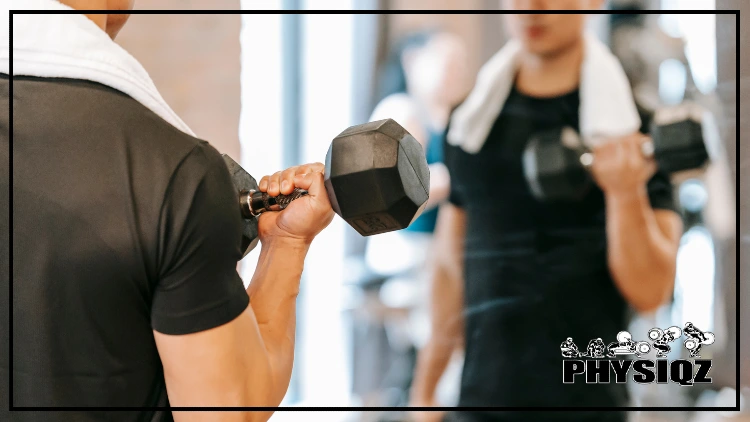
Comparing the average weight men and women should curl is the best way to determine whether or not curling 40 lb dumbbells is impressive.1 But as with gender, a person’s weight matters too so the curling strength standards below will show how much people at different weights can curl.
In addition, we’ll take a look at how often you should move up in weight and ways to increase your curling weight so you can exceed the 40lb dumbbell curl in the near future!
Is Curling 40 Pound Dumbbells Impressive?
Curling dumbbells is a foundational workout for the gym or the home. The average adult man can technically curl a 40-pound dumbbell at least once without too much training, but technically is the keyword and they’re unlikely to do so in a controlled manner.
This average curl typically involves some form of cheating. According to a case study, there are common and incorrect workout methods that people use when curling.2 Things like swinging the arm or contorting to engage muscles that shouldn’t be part of a curl.
Not only does this shoddy form make the 40-pound curl artificially easy, but it risks harming the ligaments. Reducing the risk of injury from working out requires a person to perform real, proper dumbbell curls with weight they can control.3

Source: EXTREME-PHOTOGRAPHER via Canva.com4
In this case, being able to control 40 lb dumbbells well enough to complete full sets of 40 with good form is an impressive, intermediate-term curling goal men should pursue. Almost no untrained men will be able to curl a 40 lb dumbbell for multiple reps right away. With few exceptions, being able to curl a good, short set of 40 takes months of steady work.
At that point, though, it is a good bicep curl weight for a man.
How Much Weight Can Most Men Dumbbell Curl? (Average Curl Weight For Men)
The weight that men can curl varies widely based on age, size, and the amount of training a person has completed. The training modalities make a difference, too because all else being equal, a powerlifter will be able to curl more than a bodybuilder.
Virtually all people will fall into one of five weight groups each for men and women, and then into one of five tiers based on their level of training. The main potential exception to the standards are people who work physical jobs and have high levels of strength, but aren’t accustomed to lifting.
They might start in the beginner tier and move up to intermediate or even advanced fairly quickly, but such people are the exception rather than the rule.
New Lifter:
Speaking of tiers, the first is the new lifter. This covers people who haven’t had any appreciable strength training and who are in their first weeks of lifting. At this point, the body responds rapidly to the new stimuli and it’s possible to feel modest strength gains between every session.
However, the most important thing in this period is to develop good form and safe workout habits. New lifters can expect to curl 5-15 lbs dumbbells in each hand depending on their bodyweight.
Beginner:
After 1-2 months of training, the next tier is beginner, which lasts for several months. Comparing a person’s untrained strength to their strength throughout the beginner period, they’ll see remarkable gains for such a short time. Doubling or tripling curling performance is very realistic within these first six months of regular training.
After this point, it can take another year or two to double curling weight again. Beginners can expect to curl 15-25 dumbbells.
Intermediate:
Six months of steady training elevate someone to the intermediate tier. By this point, their form should be excellent and their overall strength and health will be far better than when they started. However, their so-called noob gains will have run out, and making further progress will take more planning and discipline.
Many people who train casually will plateau at the intermediate level, but it’s a respectable level of strength to maintain. Intermediate lifters will be able to curl 25-40 lbs dumbbells.
Proficient:
Those who push through intermediate with a more rigorous training plan can expect to reach the proficient level about two years after they begin training. They’ll likely be able to curl more than four times as much as when they started, not to mention that they’ll be among the strongest members of the population. Proficient lifters can usually curl 40-50 lb dumbbells.
Expert:
It takes five years or more as well as extreme dedication to reach the expert level. This tier represents professional, competitive bodybuilders who largely dedicate their lives to building strength. High intensity and long-term commitment are necessary to continue making impressive gains after years of lifting, and experts typically curl 35-50% more than those in the proficient tier.
That seems modest compared to the drastic gains that beginner and intermediate lifters achieve, but the human body’s ability to gain muscle has diminishing returns.
Expert lifters can curl 50+ pounds, but it all depends on how they’re training, their objectives, and body weight.
Average Curling Weight By Body Weight
Typical one-armed curling weights range from 10 lbs for a smaller, untrained man up to 135 lbs for a bulky expert. This is important to keep in mind with regard to the question of whether curling 40 pound dumbbells is good.

Photo by Andres Ayrton on Pexels5
The answer varies by weight; a 130 pound man curling 40 lb dumbbells is quite respectable, but a man twice his size may want to aim higher. This are the strength standards for the average dumbbell weight for a man, depending on his size and experience:

Curling 40 pound dumbbells is good for women and it’s actually much better than good because only a small percentage of women will be able to curl dumbbells at this weight, since women have a lower ceiling for this kind of strength training.
Only highly experienced female lifters can expect to curl 40 lbs, and while it’s an achievable goal it’s not something for everyone. If a practical goal for the average man is curling 40 lb dumbbells, then a similarly practical goal for women would be 25-30 lbs.

How Much Weight Should I Curl With a Dumbbell as a Beginner?

Source: Satyrenko via Canva.com6
Anyone who’s just starting out lifting and wondering what they can curl should look at the charts above. Starting with 5-15 lbs is realistic for most men and women, although there are plenty of exceptions to this rule where someone can start at a higher weight.
However, there’s no need for a person to immediately push to the highest weight they can handle. Instead, they should start with something that feels a bit easy for the sake of building form and getting accustomed.
Numerous enthusiastic beginners tackle weights their muscles appear capable of handling, only to quickly find themselves questioning why their forearms hurt during curls. This is because they overdid the weight, which typically results in injuries to the tendons and ligaments in the elbow.
People should expect to underperform at first and plan to take it easy until they’ve been curling with dumbbells or a light resistance band for a few weeks.
Curling a low weight still does some good, curling too much weight can lead to injuries that might not heal for months. A smart beginner will start out with low weight and focus on maintaining good form, only gradually increasing weight as they become comfortable.
How Long Should I Wait to Increase Curling Weight? How Often Should I Move Up in Weight?
A reliable progressive overload workout plan is crucial for safe and effective curling. While that sounds complicated, it’s really quite simple. The core principle of progressive overload is to challenge the body more in some way as it becomes accustomed to new challenges. With curling, that means increasing weight once the body is able to comfortably handle multiple full sets with good form.
What it means to perform a dumbbell curl with good form can vary depending on the specific type of curl and the shoulder position.7 While common variants such as the hammer curl, preacher curl, and overhand curl involve different forms, here are the guidelines for the standard curl:
- Keep the elbow in place at the side of the torso with a supinated (underhand) grip on the dumbbell
- Lift the dumbbell at a moderate speed
- Pause for a second at the top of the lift
- Lower back to the starting position slowly
Short sets with high weight have their place, but that’s a more beginner-intermediate concept. To kick off a beginner hypertrophy program, the initial step is to discover a balanced and manageable weight, one where the body finds it challenging to complete 3-5 sets of 12 reps.
Then, they can train with that weight until they can reliably do the full three sets. This is the right time to increase weight or the number of sets to maintain the challenge to the body and keep on promoting growth.
The amount of time that a person spends on one weight isn’t something that has a universal answer. Some people will progress more slowly due to insufficient protein intake, cheating on reps, a slower training schedule, or some sort of disadvantage. However, anyone can build muscle and strengthen their biceps with dumbbell curls to achieve their curling weight goals.8
How To Increase Increase Curling Weight & Achieve a 40 Pound Dumbbell Curl
There are many steps involved in maximizing muscle hypertrophy and overall strength gains to achieve a 40 lb dumbbell curl.9 While a basic progressive overload program built around three sets of 40 lbs will eventually get someone there assuming they get adequate recovery, that barely scratches the surface of what’s possible.
To enhance the effectiveness of your workouts and achieve faster gains, include compound exercises, monitor volume landmarks, adhere to the shoulder protocol for strength and mobility, vary rep ranges, and prioritize recovery.
Work Smarter & Harder
While the bicep is primarily engaged during a dumbbell curl, it’s worth noting that other exercises are also effective for targeting this muscle. One great companion is the chin-up (pull-up with a narrow, supinated grip as opposed to a broad, pronated grip), which targets the bicep but also hits the shoulders and supporting muscles.
While isolating exercises like dumbbell curls are excellent for reaching maximal muscle fatigue, compound exercises like chin-ups produce greater hormonal benefits and help provide the body with more diverse challenges.
Part of that diversity also consists of different rep ranges. While 3-5 sets of 12-20 reps is a good go-to, changing it up with fewer reps and higher weights helps build strength and prevent plateauing. With compound exercises and diverse rep ranges covered, the last part of the recipe is proper volume.
Volume is another key concept. There are two ways to measure it, either in the total amount of weight a muscle has moved or in the number of times a person pushes it close to muscle failure. The second definition is more practical, and under this definition, an ideal weekly volume for the biceps will consist of at least eight sets.
Doing three sets of bicep curls and one set of chin ups twice a week will hit that minimum ideal goal, although there’s plenty of benefit to shooting higher.
Optimize Recovery with Sleep & Nutrition
Today’s sleep-deprived world often asks if 6 hours of sleep is enough to build muscle but the unfortunate truth is that it’s inadequate. Aiming for at least seven hours of sleep is ideal to promote good recovery and muscle growth.
The other key component of recovery is proper nutrition, particularly protein intake. A person should consume at least 0.7g of protein per pound of body weight to support hypertrophy, and this should be spread throughout the day. Despite common beliefs, a groundbreaking study about the protein timing myth reveals that there’s no advantage to consuming a large amount of protein immediately after a workout.
Many people can pick up a 40-pound dumbbell, but that’s not the same as being able to curl as much as a healthy man should be able to handle. The answer to whether curling 40-pound dumbbells is good is that curling it with one arm is impressive, but only with proper form.
Frequently Asked Questions
When Is Curling 40 Pound Dumbbells Good?
For men above 200 pounds, curling 40-pound dumbbells should be a fairly easy goal to reach within a couple of months. It’s a good achievement, but not a suitable stopping point. In lower weight ranges, curling 40-pound dumbbells might take six months or longer and represents a solid achievement.
Is Curling 30-Pound Dumbbells Good Enough?
According to the book “Mass” by strength coach Dennis B. Weis, a 70-pound barbell curl reflects good health and adequate upper body strength among teenagers and smaller men (6). That’s roughly equal to a 35 pound dumbbell curl. Curling 30 pound dumbbells is good as a milestone, but most men will find that it’s better to aim higher.
Is Curling 50 Pound Dumbbells Good?
Even large men will have to work for months to be able to curl 50 pound dumbbells. It’s a great achievement for most men, but may be unrealistic for younger or smaller men.
Is Curling 60 Pound Dumbbells Good as a Long-Term Goal?
Being able to curl sets of 60 is an impressive achievement, but it may be out of reach for small men and most women. On the other hand, healthy but untrained men of 180 pounds or more can realistically expect to reach this goal in about a year.
How Much Can the Average Man Curl With One Arm?
The average man is untrained and weighs 190 lbs or less, depending on the country. As such, the average curling weight for men is about 10-20 lbs.
How Much Can the Average Woman Curl With One Arm?
An average, untrained woman won’t be able to curl much. Typically, it requires at least some training for a woman to comfortably curl more than 10 lbs with good form.
References
1EXTREME-PHOTOGRAPHER. Canva. Accessed 18 April 2023. <https://www.canva.com/photos/MAEJLFGNoNs-dumbbell-biceps-curls/>
2Faber, M. (2015, July). The majority are not performing home-exercises correctly two weeks after their initial instruction—an assessor-blinded study. NCBI. Accessed November 20th, from <https://www.ncbi.nlm.nih.gov/pmc/articles/PMC4517955/>
3BMJ. (2002, August). Reducing risk of injury due to exercise. NCBI. Accessed November 20th, from <https://www.ncbi.nlm.nih.gov/pmc/articles/PMC1123979/>
4EXTREME-PHOTOGRAPHER. Canva. Accessed 18 April 2023. <https://www.canva.com/photos/MAEJLWMkqaI-right-arm-biceps-curl-repetition-two/>
5Ayrton, Andres. “Crop man working out with weights in gym · Free Stock Photo.” Pexels. Accessed 18 April 2023. <https://www.pexels.com/photo/crop-man-working-out-with-weights-in-gym-6550845/>
6Satyrenko. Canva. Accessed 18 April 2023. <https://www.canva.com/photos/MADE-DeKzqE-sport-fitness-lifestyle-and-people-concept-muscular-bodybuilder-guy/>
7Oliviera, L. F. (2009, March). Effect of the shoulder position on the biceps brachii emg in different dumbbell curls. NCBI. Accessed November 20th, from <https://www.ncbi.nlm.nih.gov/pmc/articles/PMC3737788/>
8Peterson, M. D. (2010, November). Progression of volume load and muscular adaptation during resistance exercise. NCBI. Accessed November 20th, from <https://www.ncbi.nlm.nih.gov/pmc/articles/PMC4215195/>
9Krzystofik, M. (2019, December). Maximizing Muscle Hypertrophy: A Systematic Review of Advanced Resistance Training Techniques and Methods. NCBI. Accessed November 20th, from <https://www.ncbi.nlm.nih.gov/pmc/articles/PMC6950543/>